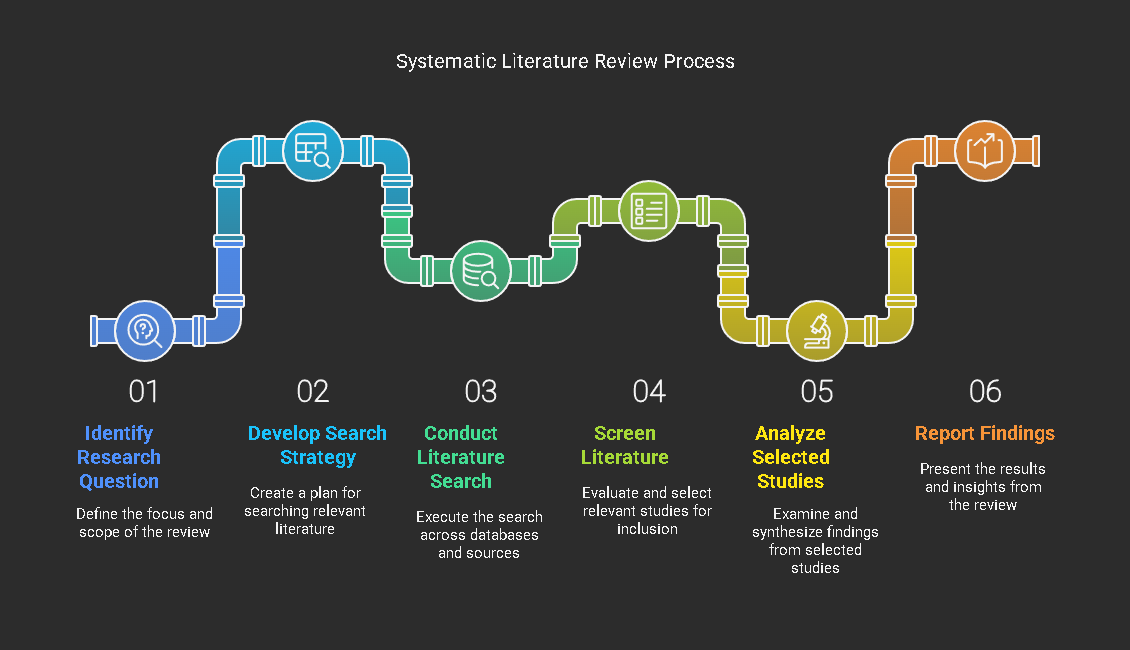How to Conduct a Systematic Literature Review: A Step-by-Step Guide
 Scribesquad
Scribesquad
Introduction
A systematic literature review (SLR) is a cornerstone for establishing a solid knowledge base in academic and professional research. Unlike traditional reviews, SLRs follow a structured approach to collecting, analyzing, and interpreting existing studies, reducing bias and enhancing reliability. But how do you conduct one effectively? This guide walks you through the process, ensuring your review is comprehensive, methodologically sound, and impactful.
Step 1: Define Your Research Question
The first step in any systematic literature review is defining a clear, focused research question. A well-structured question should follow the PICO framework:
Population: Who or what is being studied?
Intervention: What is the main focus or intervention?
Comparison: Is there a benchmark or alternative?
Outcome: What is the expected result?
For example, if you're investigating digital learning methods, your question could be: How does online education impact student engagement compared to traditional classroom settings?
Step 2: Develop a Search Strategy
A successful SLR relies on a comprehensive search strategy. Identify relevant keywords and synonyms related to your research question. Use Boolean operators to refine searches in databases like:
PubMed (health & medical sciences)
Scopus (multidisciplinary research)
IEEE Xplore (technology & engineering)
Google Scholar (broad academic sources)
💡 Pro Tip: Apply filters for peer-reviewed articles, publication date, and study design to ensure quality sources.
Step 3: Select Inclusion & Exclusion Criteria
Not all studies are relevant. Define clear inclusion and exclusion criteria to filter results effectively:
Inclusion: Peer-reviewed studies from the past five years, English-language articles, human-based research.
Exclusion: Non-peer-reviewed articles, outdated studies, irrelevant methodologies.
Using these filters ensures your review remains focused and credible.
Step 4: Conduct Data Extraction
Once you've gathered your studies, create a data extraction table to organize key details:
Study | Year | Participants | Methodology | Key Findings |
Smith et al. | 2021 | 500 students | Randomized trial | Online learning increased engagement by 20% |
Doe et al. | 2022 | 300 employees | Case study | Remote training boosted productivity |
This systematic approach helps in synthesizing information effectively.
Step 5: Assess Study Quality
To ensure validity, use critical appraisal tools such as:
Cochrane Risk of Bias Tool (for randomized studies)
Joanna Briggs Institute Checklist (for qualitative research)
GRADE Framework (for assessing evidence strength)
Studies with strong methodologies provide more reliable insights.
Step 6: Synthesize and Analyze Findings
Instead of summarizing studies individually, synthesize findings thematically:
Key Themes Identified:
Technology's Impact on Learning Outcomes
Challenges in Adopting Digital Methods
Effectiveness of Hybrid Models
Use statistical analysis (meta-analysis) when applicable to quantify trends across studies.
Step 7: Report and Present Findings
Your final review should be structured as follows:
Introduction – Background, objectives, research question.
Methodology – Databases used, search criteria, inclusion/exclusion.
Results – Key themes, trends, data synthesis.
Discussion – Implications, limitations, research gaps.
Conclusion – Summary of findings, future recommendations.
💡 Tip: Use visual aids like graphs, tables, and charts to enhance clarity.
Final Thoughts
A well-executed systematic literature review provides a strong foundation for further research. Following these structured steps ensures your review is comprehensive, credible, and methodologically sound.
🚀 Ready to enhance your research credibility? Send us a DM and let’s help with your systematic review today and build a solid academic foundation!
Subscribe to my newsletter
Read articles from Scribesquad directly inside your inbox. Subscribe to the newsletter, and don't miss out.
Written by

Scribesquad
Scribesquad
Writing is a lifestyle. I am about everything research and technology